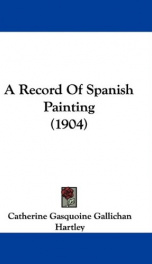a record of spanish painting

Purchase of this book includes free trial access to www.million-books.com where you can read more than a million books for free. This is an OCR edition with typos. Excerpt from book: CHAPTER II. THE HISTORY OF SPANISH PAINTING PREVIOUS TO THE FIFTEENTH CENTURY. The first records of art in Spain are little more than legendary. They are shrouded in mystery that is well- nigh impenetrable. Apart from the illuminated drawings of the religious missals, we have few authoritative examples of any painted work earlier than the fifteenth century. One or two names have survived, while here and there we find traces of time-worn relics, a mural painting, or a faded altar-piece. That is all. We have little assured knowledge; much of the work that remains is undecipherable, and all criticism is, of necessity, conjectural. Yet the study of this crude beginning is of vital significance. Many of those essential traits that at all times have characterised Spanish work are seen in this time of inception. No trace of any painting executed during the Roman and Visigothic periods remains. The first awakening of the art spirit found utterance in buildings and rude sculpture. It was not until the Christian faith grew in power that painting became the chosen instrument for the expression of art. To wholly ignore these early works in stone is impossible, for they form the basic foundation of all early painting. Spain is rich in the remains of Roman architecture. At Seville, Cordova, Merida, and innumerable other cities wrecked walls, aqueducts, amphitheatres, palaces, and towers all witness to a race of mighty builders. But these ruins transmit no adequate impression of the gloryof the Roman workmanship. Me"rida, a poverty-stricken hamlet resting among the hills that circle the banks of the Guadiana, was once called in arrogance "The Spanish Rome." The city was built by Augustus in B.c. 23, and for long it was the capital of the Roman province of Lusitania. Its great buildin... --This text refers to an alternate Paperback edition.
Info about the book
Author:
Series:
Unknown
ASIN:
B003QCIKFQ
Rating:
3.5/5 (1)Your rating:
0/5
Languge:
English
Users who have this book
Users who want this book
What readers are saying
What do you think? Write your own comment on this book!
write a commentif you like a record of spanish painting try:
Other books by this author
Do you want to exchange books? It’s EASY!
Get registered and find other users who want to give their favourite books to good hands!

